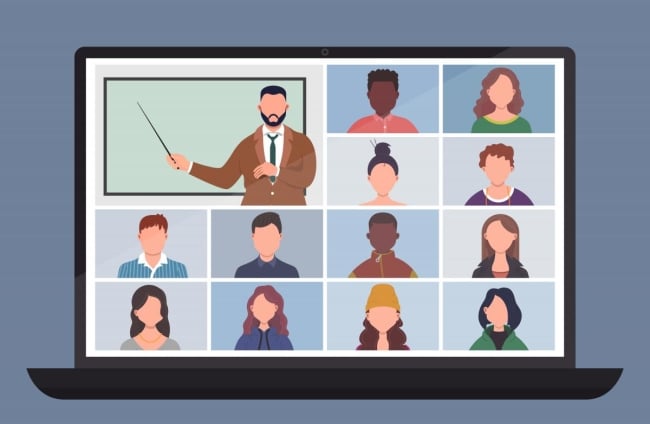You have /5 articles left.
Sign up for a free account or log in.

Yayasya/iStock/Getty Images Plus
The University of Nevada, Las Vegas, originally planned to hold about 80 percent of its courses this year in person, and 20 percent online, which would have compared with a pre-pandemic baseline of about 90 percent of courses in person and 10 percent online.
But with the summer surge in coronavirus cases, the university in July opted to rethink the schedule. About 60 percent of fall courses will now be in person, and 40 percent will be remote.
“We were hearing concerns from students who, given the circumstances in Las Vegas and Nevada, were not as comfortable coming to campus as they had anticipated being,” said Chris L. Heavey, UNLV’s provost. “We opened up the schedule in July and asked people to try to accommodate student requests for online instruction and also gave faculty who felt like they were no longer comfortable teaching in-person the option of switching their courses to remote, with a preference toward remote synchronous.”
UNLV is not alone in grappling with how to respond to the changing public health circumstances. With vaccines to prevent COVID-19 having become readily available, many colleges by and large planned for a return to in-person instruction this fall -- and then the highly transmissible Delta variant came along.
With coronavirus cases now surging, colleges are taking a variety of approaches in terms of the degree to which they’re using one tool in their virus-containment toolbox: online learning. Some colleges are offering 50 percent or more of their classes online, while others are 90 percent-plus in person.
An important factor in the decision to reduce the proportion of in-person classes at UNLV was that the university’s vaccination mandate for students will not go into effect until the spring, Heavey said. He noted as well that when the university made the decision to change up the schedule, it was not yet clear whether the university would have a mask mandate in effect this fall, as it now does.
Heavey said the reaction from students to shifting more courses online has been mixed, though he noted enrollment did tick up by 2.2 percent, or about 520 more full-time students, after the university announced the shift to a larger proportion of remote instruction.
“This is a no-pleasing-everyone scenario -- we are getting some concerns on both sides -- but by and large I think people have been understanding and it’s led to the density on the campus being meaningfully lower in a way that I think gives people additional comfort,” he said. “For sure, faculty members who perceive themselves to be at high risk appreciated the opportunity to rethink their initial decisions about the mode of instruction.”
Abraham Lugo, vice president of the Consolidated Students of UNLV, also said that students have mixed views on the shift toward more classes being remote.
“It’s very case-by-case,” he said. “A lot of students are like, ‘Oh my gosh, this is so much better, especially after having been remote. I got used to it, I have a much more flexible schedule, I love it.’ And others are saying, ‘No, I don’t like it, I don’t think my learning experience is the same level it would be if I were there in person.’ ”
Lugo said moving more courses online “is just the safest way to go, because the one consensus that everyone does have is we’re on a good trajectory. We don’t want to go into another shutdown and lose more lives.”
While UNLV is an example of a place that fundamentally reconfigured its class schedule as COVID-19 cases started surging over the summer, across the U.S. the momentum for a more “normal” in-person semester remains strong.
“What I’m hearing right now is almost everyone wants to be in person and they really want to replicate fall 2019,” said Bryan Alexander, a senior scholar at Georgetown University who has been tracking colleges’ responses to the coronavirus. “Going into July, President Biden said July 4 will be our new independence day, and then Delta hit and I think colleges and universities have not wanted to go down the road of fall 2020 again. They were really afraid that this would be costly.”
Alexander has been maintaining a list of colleges that have announced delayed starts to in-person learning or temporary shifts to remote learning in response to rising virus cases. He’s identified about 10 such “toggle terms,” as he calls them, so far.
“I think a lot of colleges are in a wait-and-see mode, start from the assumption of in-person but be ready to flip,” Alexander said. “They’re also trying to learn lessons from last year, and I think each campus learns a different lesson. Some of them have learned that in-person is worth it for them, and they’ll say we’ve got sufficient public health countermeasures and we can handle it. And others are just really afraid of a financial hit.”
Christopher R. Marsicano, assistant professor of the practice of higher education at Davidson College and founding director of the College Crisis Initiative, which studies colleges’ responses to the COVID-19 pandemic, said there’s enormous pressure from undergraduate students to be in person even as many professors are not comfortable teaching in person.
“When we think about how online is being used now, in the second COVID fall, it tends to be for some classes where pedagogically it makes sense, for classes that are targeted to nontraditional students or commuter students or in the cases like Duke right now where faculty can teach online simply because there’s such a large percentage of students in isolation,” Marsicano said.
“The use of online education is reactive, not proactive, in this case,” he said. “Last year online education was used as proactive measure to limit COVID-19 spread on campus.”
At the University of North Carolina at Chapel Hill, which in fall 2020 shifted its coursework online after a surge in virus cases, 91 percent of courses are in person this fall, and 9 percent are remote.
Pennsylvania State University is another example of an institution that has pushed a close-to-full return to in-person learning. The university says 94 percent of courses on its flagship University Park campus will be in person this fall, down just slightly from a pre-pandemic baseline of around 97 percent.
Penn State has warned that remote learning options will not necessarily be available in the event a student needs to enter quarantine or isolation.
“With the University providing a fully in-person experience this fall, most courses will not have a remote participation option,” a statement from the university says on a website explaining its fall semester COVID protocols. “Students who must enter quarantine or isolation will miss roughly two weeks of in-person classes. As in pre-pandemic years, students must work with their instructor if they must miss class due to illness or quarantine.”
Fewer colleges are offering remote learning options for international students located abroad this fall compared to last year. Leading up to fall 2020, 78 percent of colleges said that international students who could not travel to the U.S. to come to campus would be offered the opportunity to enroll online, according to a survey by the Institute of International Education. A follow-up survey for this coming fall found that 47 percent of institutions expected to offer international students the option to enroll online until they could attend in person.
Still, online learning remains an important part of the class mix at many institutions this fall. The California State University system, which went almost entirely remote in fall 2020, reports that roughly 80 percent of courses across its 23 campuses will be in person this fall, and 20 percent online, though the percentage varies substantially across campuses. The Los Angeles Times reported last week, for example, that the percentage of classes being held in person this fall is 45 percent at the CSU Long Beach campus, 50 percent at the CSU Northridge and CSU Los Angeles campuses, 65 percent at CSU Fullerton, and 85 percent at San Diego State.
The City University of New York plans to offer about 45 percent of its courses in person or hybrid and 55 percent online across the system’s 25 colleges. The system reports that the percentage of courses being taught online varies from 34 percent on the low end to 83 percent on the high end.
Before the pandemic, about 10 percent of courses across CUNY were online, according to Daniel Lemons, the executive vice chancellor and university provost.
Lemons said CUNY is in a transition phase back to in-person learning after being mostly remote last year. He said there’s strong student demand for online or hybrid classes, which he attributed to a variety of reasons, including student apprehension about the safety of being in a classroom or about commuting.
"But it could also be that I discovered that taking an online course really works for me and I want to do that again," Lemons added. “I know that’s part of it, too.”
Lemons said his sense is that faculty had a fair amount of flexibility in determining their teaching modality.
“I don’t know about every individual decision that was made about modality, but my impression from what’s been reported to me is that most faculty this fall who are teaching in person or hybrid courses chose to do that and other faculty preferred to do online, but they worked that out with their department chairs,” he said. “Ultimately, the modality with which a course is delivered really has to be a decision that’s broader than an individual faculty preference because it really has to fit with the program needs.”
James Davis, president of the Professional Staff Congress, a union representing CUNY faculty members, said some of the CUNY campuses have been more flexible with accommodating faculty requests than others. He said the union’s position is that faculty should have the choice to teach their courses remotely if they wish through Oct. 7, which is the deadline CUNY has set for students to be fully vaccinated. (CUNY’s requirement goes into effect 45 days after the U.S. Food and Drug Administration granted full approval to the COVID vaccine manufactured by Pfizer, which happened Aug. 23.)
“I think some campuses are really taking a kind of sensible and safety-first approach to either distancing or moving classes remote if faculty members request it, and others are not,” Davis said. “The countervailing pressure here is that some provosts on some CUNY campuses are saying students signed up for in-person classes and we have made a kind of unspoken contract with them that we should not break just because the Delta variant is there and just because some faculty members’ threshold for concern about that is higher or lower than others’.”
He added, “I think CUNY went very hard at the beginning of the summer with a certain understanding of what students wanted, which was to be in person. I think, of course, a lot of us wanted that. Nobody wanted the fall semester to look like the past two semesters, and I get that. The problem right now is what students want has changed, and I think what faculty and staff want has changed.”








